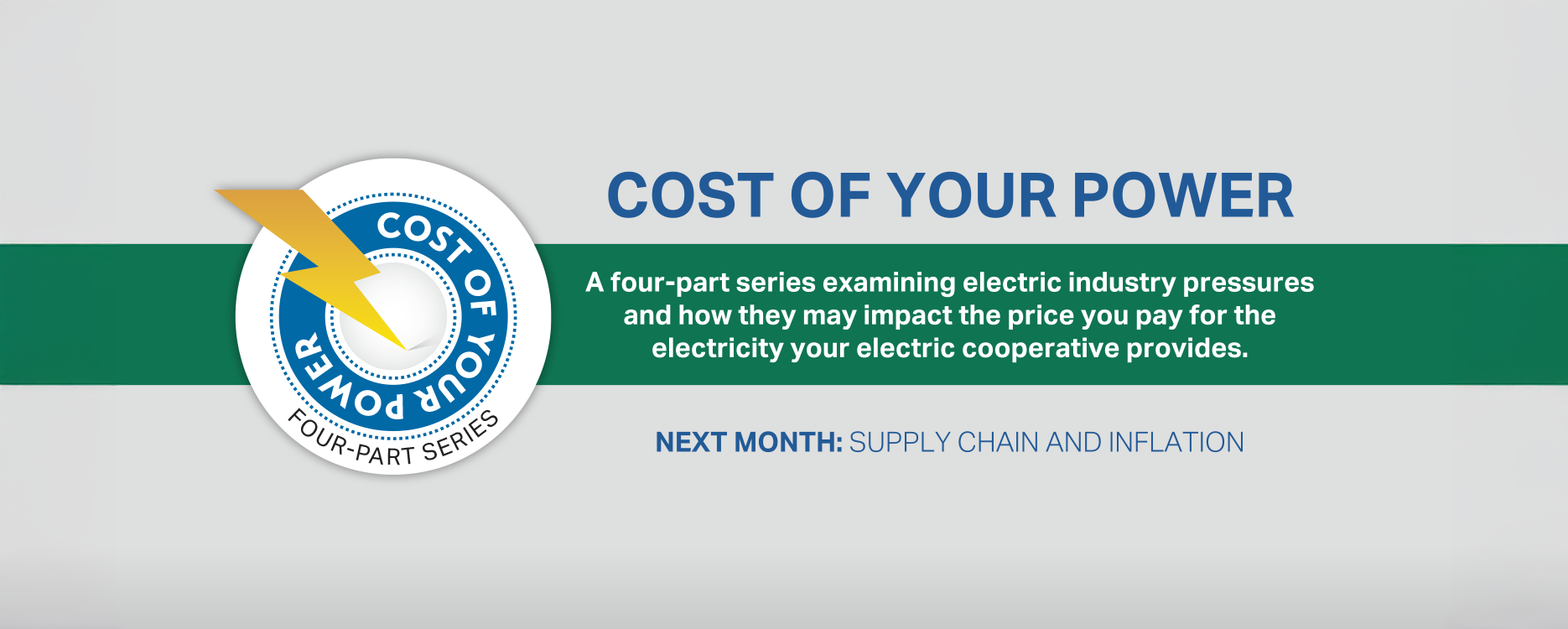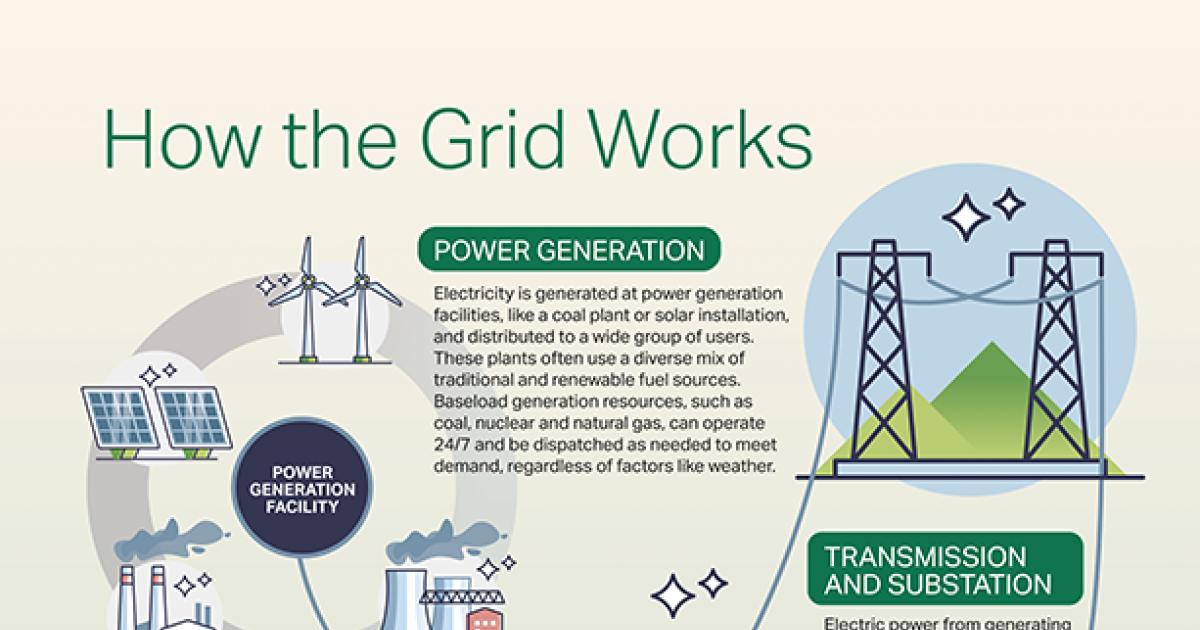
Demand growth for electricity is now higher than any point in the last two decades. Americans are requiring more electricity in their homes and on the road. Large industrial and commercial users are requiring more electricity for their operations.
Across the United States, thousands of people work every minute of every day to keep the power flowing 24/7/365. From the coal miner to the lineworker and everyone in-between, it takes an immense amount of people, resources, coordination and planning to ensure you can charge your cellphone, heat your home, dry your grain or turn on your lights.
Many never think about the long journey electricity takes to get to us. Fewer consider the challenges encountered along the way. In some ways, that’s OK. It’s a signal your electric cooperative is good at its job. It means you’re getting the reliable, affordable electricity you need when you need it.
So, when do we think about electricity? When it doesn’t work and when we pay for it.
In this four-part “Cost of Your Power” series, which begins this month and ends in April, North Dakota Living takes a big-picture look at the electric industry. We’ll examine how industry-wide pressures may impact the price you pay for the electricity your electric cooperative provides.
SUPPLY CHAIN AND INFLATION
Over the past few years, North Dakota’s electric cooperatives have seen huge upward swings in price, demand and wait time for materials. Supply chain issues, coupled with record inflation, are impacting utilities.
In the five years preceding the COVID-19 pandemic and resulting supply chain disruptions, North Dakota co-ops experienced a 2% increase in the cost of pad-mounted transformers (which step down electric voltage for safe use in members’ homes). Between 2020 and 2022, the price of those transformers increased by 50%.
Substation transformers and high-voltage breakers, both crucial components for infrastructure, have a current wait time of two years. The wait time for bucket trucks, which rural electric lineworkers log many miles in each day, is 2.5 years.
Electric cooperatives have adjusted to supply chain challenges by carrying more inventory on hand. Having materials ready to deploy is critical for power restoration after a storm and serving the energy needs of members, who may be planning a new construction project, building a farm shop or expanding a business.
WHOLESALE POWER
The bulk power system and wholesale power market is complicated.
In the early electric system, a power provider would build and maintain its own generating unit or facility to serve its member load. Many North Dakota lignite coal facilities, for example, were built to generate electricity for cooperative members across a multistate region.
In the 1990s, the energy industry shifted to a market-based system. Every day, utilities forecast the amount of electricity needed to serve their loads. Then, that load is bid into the market.
Increasing demand, a changing resource mix, the retirement of reliable baseload generation and lagging transmission infrastructure impact today’s wholesale power costs, creating market volatility.
Wholesale power costs account for the majority of an electric distribution cooperative budget – roughly 70% to 80% on average. Many wholesale power providers in the region have recently announced rate increases, which are passed on to power purchasers.
BALANCING SUPPLY AND DEMAND
Reliable electricity relies on a delicate balance of supply and demand. Many links in the power supply chain must work in harmony to achieve a stable electric system, far before electricity is distributed to members’ homes, farms and businesses. And, factors impact both supply and demand.
Factors impacting supply include the transition away from fossil-fuel generation toward renewable, intermittent resources, the disorderly retirement of baseload generation, siting and permitting delays, lagging infrastructure development and government regulation.
The demand side of the equation is impacted by the electrification of our homes and the transportation sector, large loads from industrial users, data centers and artificial intelligence, and increasing peak demand.
ELECTRIC COOPERATIVE DIFFERENCE
Ultimately, the combination of these industry factors may (or may not) affect you as an electric cooperative member. Electric co-op boards will consider these factors and others when determining rates. Across the country, cooperatives are weighing how to absorb these costs or adjust rates.
If you are concerned about your electric bill, contact your electric cooperative. They are your local energy experts who can discuss programs you may qualify for, ways to reduce your energy usage and technologies which could yield energy savings.
The good news is you are an electric cooperative member, which is different from being a customer of an investor-owned utility. Electric cooperatives are not-for-profit utilities, which operate at cost and are owned by the consumers they serve. They are not in this business to make money. They do not return profits to far-away shareholders. At the end of the year after all operating expense are paid, any margins (“profits”) are returned to cooperative members as capital credits, based on the amount of electricity used.
The other good news is North Dakota electric cooperative members enjoy some of the lowest electric rates in the country. When you think of your electric bill in this way, electricity remains a good value.
Find the second feature in the “Cost of Your Power” series in the February issue of North Dakota Living.
___
Cally Peterson is editor of North Dakota Living. She can be reached at cpeterson@ndarec.com.
EDITOR’S NOTE:
In North Dakota, rate making is a function of local electric cooperative boards of directors, which are democratically elected from the membership by the co-op members. Electric co-op boards weigh many factors when determining rates.
Across the country, many electric cooperatives (though not all) have implemented, are considering or will consider a rate increase. The Cost of Your Power series will present some of the current industry-wide, high-level pressures which factor into rate-making decisions by electric cooperative boards. This series will not include information specific to your local electric cooperative. Contact your local electric cooperative for information about your electric rates.










